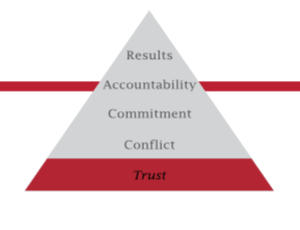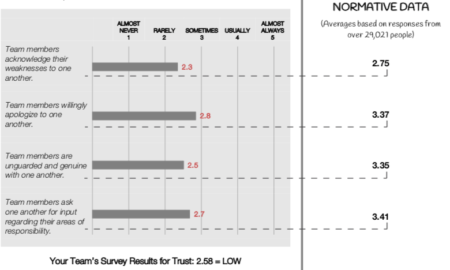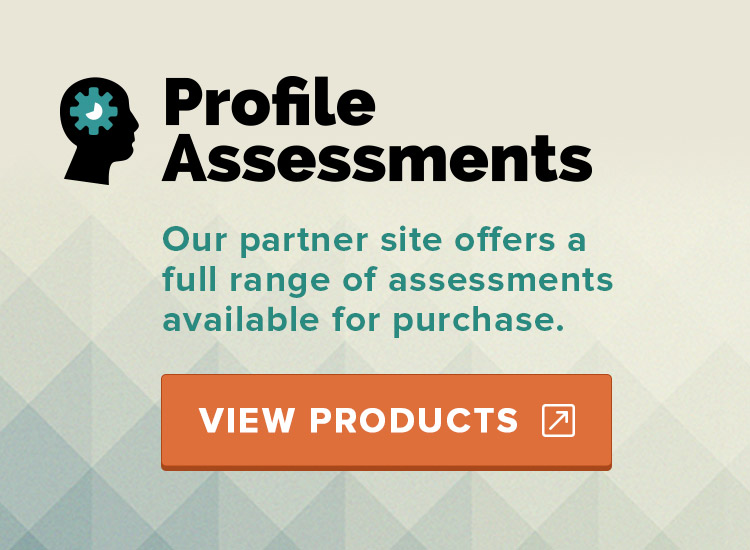4 Crucial Questions to Build Team Trust
Part 2 of the Blog Series: How to Put the Five Behaviors of a Cohesive Team into Action.
Click here to read Part 1: Five Behaviors That Drive Team Results
The foundation of building a cohesive team is Building TRUST. The word trust can have many interpretations. When  considering Trust on your team, it is not centered around the ability to predict a person’s behavior based on past experience.
considering Trust on your team, it is not centered around the ability to predict a person’s behavior based on past experience.
Trust means:
• A willingness to be completely vulnerable with one another
• Confidence among team members that their peers’ intentions are good and that there is no reason to be protective or careful around the team.
To get to the core of Trust on your team, ask yourself four questions and rank your response on a 5-point scale:
5 = Almost Always; 4 = Usually; 3 = Sometimes; 2 = Rarely; 1 = Almost Never
1) Team members acknowledge their weaknesses to one another.
2) Team members willingly apologize to one another.
3) Team members are unguarded and genuine with one another.
4) Team members ask one another for input regarding their areas of responsibility.
How did you evaluate your team? If you are open and honest, you likely scored along the mid-range or lower. Consider this example below:
This example reflects the majority of teams we work with providing a powerful opportunity to engage in dialogue to increase our understanding of how Trust or the lack of Trust is impacting the team. Both the team’s assessment and normative data are included. As you can see, Trust is an area that needs attention in the workplace.
Let’s look at each question individually:
 Members of great teams don’t waste time and energy putting on airs or pretending to be someone they’re not. Everyone on the team knows that no one is going to hide his or her weaknesses, which helps build a deep and uncommon sense of trust.
Members of great teams don’t waste time and energy putting on airs or pretending to be someone they’re not. Everyone on the team knows that no one is going to hide his or her weaknesses, which helps build a deep and uncommon sense of trust.
In this example, team members don’t appear to be willing to admit to their weaknesses, at least not to each other. Rather, team members likely hide their personal limitations for fear of what others might thing. A team must be willing to engage in vulnerable dialogue to address this issue.
 When great teams have vulnerability-based trust, they are completely comfortable being transparent and saying things like “I screwed up” or “your idea was better than mine.” The level of trust on a team will improve greatly if members are able to set egos aside in order to move forward.
When great teams have vulnerability-based trust, they are completely comfortable being transparent and saying things like “I screwed up” or “your idea was better than mine.” The level of trust on a team will improve greatly if members are able to set egos aside in order to move forward.
Although there is some disagreement in this example, most of the team sees its members as uncomfortable apologizing to one another for mistakes. People may feel compelled to hide slip-ups and avoid “outing’ themselves with direct apologies. The willingness to say “I’m sorry” is an important contributing factor to establishing trust on the team.
 At the heart of vulnerability lies the willingness of people to abandon their pride and their fear and simply be themselves. While this can be a little threatening and uncomfortable at first, ultimately it becomes liberating for people who are tired of overthinking their actions and managing interpersonal politics at work.
At the heart of vulnerability lies the willingness of people to abandon their pride and their fear and simply be themselves. While this can be a little threatening and uncomfortable at first, ultimately it becomes liberating for people who are tired of overthinking their actions and managing interpersonal politics at work.
However, this type of vulnerability is tough for a lot of teams. In this example, the data suggests that the team is having trouble letting down their guards and showing their true colors. This lack of transparency may hinder the team’s ability to have a free exchange of ideas, which, in turn, may challenge the team’s ability to build trust.
 When individuals trust that their teammates have their best interests in mind, they feel comfortable asking on another for input and opinions. They aren’t worried about being exposed or shot down.
When individuals trust that their teammates have their best interests in mind, they feel comfortable asking on another for input and opinions. They aren’t worried about being exposed or shot down.
Based on the data here, members of this team may be reluctant to ask for feedback. Team members may think that doing so will make them seem incapable of handling their own work, or maybe they’re simply overconfident in their own ideas. Maybe there is an underlying tension that keeps team members from sharing. Seeking more input can lead to better ideas and solutions that ultimately drive team success.
Key Takeaways
• The data supports that most teams can benefit from increasing trust.
• Building vulnerable trust can be a scary process for team members.
• Trust is the essential cornerstone to build upon the Five Behaviors. Without it, teams will struggle achieving high levels of performance.
• Engaging the team in a dialogue using the 4 Crucial Team Trust Questions provides a platform for meaningful and authentic dialogue that can lead to a deeper level of trust across the team.
Recommendations:
For a simple application of the 4 Crucial Team Trust Questions, have each individual team member assess team performance across these four questions. Be sure to have responses reported anonymously to ensure quality and realistic feedback.
To take this to a deeper level of understanding and application, have your team assessed using the Five Behaviors of a Cohesive Team Assessment.
Check out a Five Behaviors of a Cohesive Team Sample Assessment
Stay tuned for our next post, ‘Managing Conflict using the Five Behaviors of a Cohesive Team’
Contact us to learn more about the Five Behaviors Model and the positive impact it has for teams
 Learn More about Corporate Teams Profile Assessment offerings, visit our partner site: www.ProfileAssessments.com
Learn More about Corporate Teams Profile Assessment offerings, visit our partner site: www.ProfileAssessments.com
